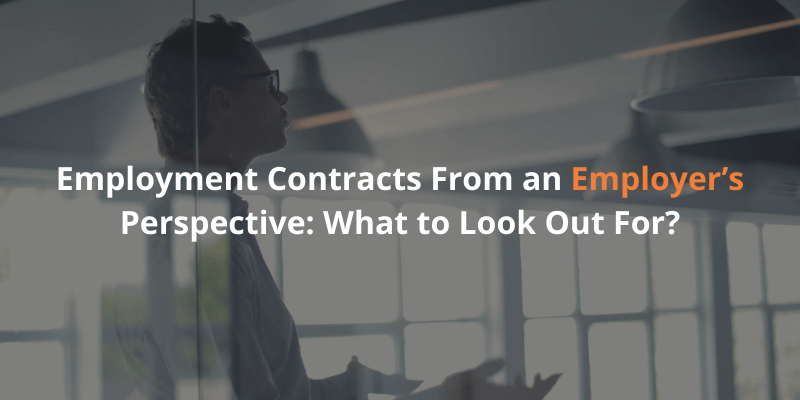Navigating the Fine Print: A Guide for Employer to Understanding Basic Employment Contracts
16 Aug 2024
10 Aug 2020
min read

The employer usually provides its form of employment contract template to the employee. This gives the employer significant advantages of including terms in favour of the employer in the employment agreement, as most employees would not seek to negotiate such an employment agreement. Most employers, whether first-time or seasoned, would want to ensure that all the key and relevant terms have been included in the employment contract to avoid issues and disputes in the future.
This guide discusses the key terms to be included in the employer's basic employment contract template, as well as go through a list of frequently asked questions by the employer relating to employment law.
A. What is an Employment Contract?
An employment contract is a legally enforceable agreement between an employer and an employee where specific employment terms and conditions are being made clear. Generally, an employment contract contains details such as the employee’s duties, duration of the contract, health insurance policy, wages and entitlements, grounds for termination, termination procedures, confidentiality provisions, etc.
An employment contract forms a vital part of an employment relationship as it manages expectations between parties and clearly sets out the terms and conditions of the employment. We understand writing an employment contract from scratch might be difficult. Keep reading this article to find out 5 important things to look out for in your employment contract, or scroll down to the bottom to download our employment contract templates!

B. Probational Period
1. What is a Probational Period?
A probational period is a trial period of time at the start of employment for newly recruited employees. Such periods help employers to determine whether the newly recruited employee is suitable for the position and where unfit candidates may be dismissed with little notice if the probational clause has clearly set out such requirements.
Probational periods are important as it provides you with a chance to determine whether the newly recruited member is a right fit for the position they were recruited for. Even the most effective recruitment process may not reveal a full picture of a candidate’s competencies and weaknesses.
The new employee may turn out to be very different from how they came across during the recruitment process. You can take quick actions and find replacements if you realise that the newly recruited employee is incompetent or isn't a good fit into the company’s culture after they started work.
2. How Should I Set Out a Probational Period in the Employment Contract?
As there are generally no statutory requirements regarding the length and terms of probational periods, you should insert a probational period clause in the employment contract by including the following details about probational periods.
These details should be stated in the clause:
- The length of the intended probational period;
- What expectations should employees meet to pass their probational period;
- Termination procedures for terminating employees on probation; and
- Reserving rights to extend the probational period.
Regarding the length of probational periods, they shall be reasonable despite the absence of statutory legal requirements to avoid being challenged. You might consider the nature of the assessed role and how long you need to decide on whether a certain candidate is suitable for a role before deciding the length of a probational period.
In general, probational periods last for one to three months, although it is common for employers to extend the probational period for another three months to give the newly recruited employee who is not up to speed opportunities to improve.
3. What are the Entitled Rights of Employees on Probation?
Employees on probation are entitled to the same statutory rights as employees who have finished their probations, hence employees on probation are entitled to minimum wage, statutory sick pay, right to protection against unfair dismissal and unlawful discrimination.
For further entitlements that are not required by the legislation, you might exercise your own discretion on whether the employees shall be entitled to such by stating them clearly in the Probational Clause.
C. What Kinds of Leave are Employees Entitled to?
To avoid confusion, possible disputes and to precisely calculate an employee’s entitlement to leave, you should stipulate details of benefits and rights entitled by employees clearly in the employment contract. Details such as how many days of leave are the employees entitled to, how much notice should they give in advance, and whether any supporting documents are required should be included in the clause.
Although you are free to negotiate with your employees to decide whether the extra leave would be granted to them, there is always a legal minimum regarding such a right to take a leave that you should strictly adhere to.
As the legal minimum regarding different kinds of leave varies from jurisdiction to jurisdiction, you are strongly advised to double-check with your local legal representatives before letting your employees sign the contract.
1. Annual Leave
Annual leave is paid time off work provided to employees and it can be used for any purpose. The legal minimum regarding annual leave entitlements are summarized below:
-
-
-
United Kingdom
The number of annual leave entitlements depends on their employment status, as summarised below:
Employment Conditions
Annual Leave Entitled to
Workers working 5 days per week
At least 28 days
Part-time workers
At least 5.6 weeks’ paid leave
People working irregular hours
Paid time off for every hour they work
-
-
-
-
-
Australia
The number of annual leave entitlements depends on their employment status, as summarised below:
Employment Conditions
Annual Leave Entitled to
Full-time and Part-time workers
4 weeks (subject to ordinary working hours)
Shift workers
5 weeks
Casual Employees
N/A
Annual leave accumulates from the very first day of employment and used annual leave will accumulate from year to year. The following table summarises when annual leave will and will not be accumulated:
Annual Leave Accumulates when Employee is on
Annual Leave Doesn’t accumulate when Employee is on
· Probation;
· Paid annual leave and sick leave;
· Community service leave; and
· Long service leave.
· Unpaid annual leave;
· Unpaid sick leave;
· Unpaid parental leave; and
· Unpaid family and domestic violence leave
-
-
-
-
-
Hong Kong
In some jurisdictions, the number of annual leave entitlements depends on the employee’s length of service. For example in Hong Kong:
Years of Service
Annual Leave Entitled to (days)
Less than 2
7
3
8
4
9
5
10
6
11
7
12
8
13
9 or above
14
In addition, up to 3 days can be granted separately for leave entitlement not exceeding 10 days, whereas at least 7 days should be granted consecutively for leave entitlement exceeding 10 days.
-
-
2. Maternity Leave
Maternity Leave is a period of time to allow pregnant employees to take time off from work. In addition, you must bear in mind that dismissing pregnant employees without giving proper written notice and reasons will constitute an unfair dismissal, and you might be legally responsible for that. The legal minimum regarding Maternity Leave entitlements are summarised below:
-
-
-
United Kingdom
A pregnant employee may take up to 52 weeks of Statutory Maternity Leave and must take 2 weeks’ leave when the baby is born upon meeting the following conditions:
- Her employment status is an employee instead of a “worker”; and
- The employee has given the employer the correct notice.
In addition, employees are entitled to 18 weeks of unpaid parental leave after the child’s birth, with a maximum of 4 weeks per year.
-
-
-
-
-
Australia
In Australia, Maternity Leave forms part of Parental Leave Entitlements for employees who are expecting a child. Employees who have worked for their employer for at least 12 months before the expected date of birth/ date of adoption/ starting date of leave and have responsibility for the care of the concerned child are entitled to 12 months of unpaid Parental Leave and an additional 12 months of leave upon request.
Casual Employees who have been working for their employer regularly and systematically for at least 12 months and have a reasonable expectation of continuing work with the employer on a regular and systematic basis are also entitled to 12 months of unpaid Parental Leave.
-
-
-
-
-
Hong Kong
According to the recently gazetted Employment (Amendment) Ordinance 2020, pregnant employees are entitled to 14 weeks of paid Maternity Leave upon meeting the following conditions:
- The pregnant employee has been employed under a continuous contract for not less than 40 weeks immediately before the commencement of maternity leave;
- The pregnant employee has given notice of pregnancy to the employer; and
- The pregnant employee produced a certificate specifying the expected date of confinement by professionally trained people upon request of the employer.
Pregnant employees who have been employed for less than 40 weeks immediately before the commencement of maternity leave are entitled to 14 weeks of unpaid maternity leave.
-
-
3. Paternity Leave
Paternity Leave is a period of time when an expecting father or a partner of an expecting mother can take time off from work.
The legal minimum regarding Paternity Leave entitlements are summarised below:
-
-
-
United Kingdom
Male employees are entitled to 1 or 2 weeks of paid Paternity Leave upon meeting the following conditions:
- He is an employee who has been continuously employed for at least 26 weeks up to any day in the 15th week before the baby is due; and
- He gives correct notice to the employer informing the employer of the due date of the baby, the intended start date of Paternity Leave and whether he wants 1 or 2 weeks’ leave.
As an employer, you may require your male employees to give notice in writing and using your own version of form SC3 regarding Paternity Pay entitlements by inserting a clause about Paternity Leave in your employment contract.
-
-
-
-
-
Australia
In Australia, Paternity Leave forms part of the Parental Leave Entitlements. Please refer to Section 2.2 for further details.
-
-
-
-
-
Hong Kong
Male employees are entitled to 5 days of Paternity Leave for each confinement of their partner upon meeting the following conditions:
- He is the father of a new-born child or a father-to-be;
- He has been employed under a continuous contract; and
- He has notified his employer in accordance with the law.
Male employees may take paternity leave at any time during the first four weeks before the expected date of delivery and the ending ten weeks after the actual birth of the child.
-
-

D. Notice Period
1. What is a Notice Period?
The notice period is the time period between (1) the employee handing in their notice, or (2) the employee was notified to be dismissed, and the actual end of his/her last working day.
It starts when the employee submits a formal resignation letter indicating the intention to terminate the employment relationship, or when you give the employee a notice of termination of employment in any form.
Notice period benefits both you and your employee and there is always a legal minimum regarding the required length of the notice period. The observation of a notice period can provide you with sufficient time to look for another suitable candidate to replace the dismissed employee and request the leaving employee to train his/her successor.
This amount of time reduces the hindrances caused to your company’s operations due to the effect of dismissal or termination of employment.
Please refer to the following link for a template of Employee Resignation Relieve & Full and Final Settlement:
2. How Much Notice Should I Give My Employees?
You should include a termination clause stating (i) the length of notice period an employee shall give should they resign or when you dismiss an employee, (ii) termination entitlements such as termination pay in lieu of notice, and (iii) the correct way to give notice to the other party.
The length of the notice period stated in the employment contract is also called a contractual notice period. If you fail to give your employees the minimum length of notice period stated in the employment contract, you might be legally countable for a breach of contract and your employees may file legal claims against you.
The termination clause can be drafted in favour of an employer by limiting the amount of money that an employer would be entitled to pay upon termination and requiring a leaving or dismissed employee to serve longer notice periods in order find a suitable successor to fill in his/her role.
In addition, there are no legal restrictions requiring the notice period imposed on an employer and its employee to be the same in some jurisdiction(s), such as Hong Kong.
You are free to negotiate with your employees to agree on a certain length of the notice period required in terminating the employment relationship. However, you must adhere to statutory limitations as there is always a legal minimum.
Statutory limitations regarding the length of the notice period may vary according to the employee’s employment status. For example, employees on probation are usually entitled to a shorter notice period and employees that have been employed for a very short period of time might not be entitled to any right of notice. In such cases, the Common Law doctrine of reasonable notice applies. You are advised to seek appropriate legal opinions regarding the law in your jurisdiction to ensure full compliance with the law.
3. Can I Dismiss an Employee Without Giving Any Notice?
You can only instantly dismiss an employee without any notice period or payment in lieu of notice if an employee committed gross misconduct. For example, employees may be summarily dismissed if he/she willfully disobeys a lawful and reasonable order, misconducts him/herself, is guilty of fraud or dishonesty or habitually neglects his/her duties in Hong Kong.
In the United Kingdom, employees may be summarily dismissed for gross misconducts such as theft, physical violence etc. Although the grounds for summary dismissal vary from jurisdiction to jurisdiction, summary dismissal is seen as a very serious disciplinary action by courts.
You should only resort to summary dismissal after conducting sufficient investigation into the matter and the employee has committed very serious misconduct and fails to improve after repeated warnings.
E. Garden Leave
1. What is the Garden Leave Clause?
Garden Leave Clause requires employees to stop performing their job duties and stay away from the company’s premises while the employment contract continues, and is usually enforced during the period of employee’s job transition.
Garden Leave Clauses are always included in senior employees’ employment contracts as they have wider access to sensitive proprietary or client information. Employees are required to sit out until the Garden Leave period expires before starting their new jobs.
During the Garden Leave period, employees are usually required to return all company properties (such as computers, documents, and digital devices), being kept away from clients, colleagues, confidential information and trade secrets of your company, and being confined from working in office areas.
Although employees are entitled to all the standard pay and entitlements stated in their employment contract, going on a Garden Leave is different from going on a paid leave – employees have to be on standby and make themselves available upon your request. Although in real life employees being placed on Garden Leave are rarely given any actual job duties, they might be ordered to deal with handover procedures.
2. Why Should I include a Garden Leave Clause in Employment Contract?
Garden Leave Clauses are important as they protect potential business damages or any harm to a company’s reputation by excluding the leaving employee from the company’s business. They are often included in senior members’ employment contracts as they have greater access to the company’s confidential information and are more capable to perform harmful acts to the company.
Putting senior employees on Garden Leave aims to keep them away from the industry to ensure the information they possessed goes outdated.
You may request your employee to take garden leave only if there is a Garden Leave Clause on the employment contract. In the absence of an express Garden Leave Clause, you can only effectuate garden leave if there is mutual consent upon the matter or when the Court rules that the employee does not have the contractual right to work. However, recent judicial development shows that courts are inclined to rule in favour of the employee in such matters.
F. Post-Termination Restrictive Covenants
1. What is a Post-Termination Restrictive Covenant?
Post-termination restrictive covenants are commonly stipulated in an employment contract seeking to protect the employer’s interest when an employee leaves his/her position. It is vital to insert such clauses in employment contracts, especially for senior members’ contracts as a protectionist measure.
Every business has its own confidential information and trade secrets which are the secret weapon to its success. Employees who had in-depth knowledge of such invaluable information are integral to your success and might also be an attractive asset to your competitors seeking to encroach upon your market after they left your company.
Ex-employees taking advantage of your company’s confidential information, strategic plans, operational details and clients’ list will seriously harm your business. Well-drafted restrictive covenants also act as a strong deterrent to employees from misbehaving.
With enforceable restrictive covenants included in your employment contracts, you are able to take court actions when your former employees commit a breach. You may also be entitled to remedies such as seeking injunctions and claiming compensation, depending on how your clauses are drafted and the court’s discretion.
If your employee breached the Post-Termination Restrictive Covenant stipulated in their employment contract, you may wish to refer to the templates below:
2. Types of Post-Termination Restrictive Covenants
Here are some of the most common restrictive covenants:
- Non-Compete Clauses aims to protect your market advantages by preventing former employees to work for a competitor, or for a business with similar nature to your company.
- Non-Solicitation Covenants aims to protect your client's and customers' network by preventing former employees to contact or approaching them for a stipulated period of time.
- Non-Poaching Covenants aims to protect the stability of your workforce by preventing former employees from poaching former colleagues for a stipulated period of time.
- General Confidentiality Clauses aims to protect confidential information and trade secrets of your company (such as operation details, clients list, database etc.) by preventing former employees from disclosing them to third parties.
3. Whether the Restrictive Covenants are Enforceable?
In order to avoid unnecessary disputes and ensure the enforceability of the restrictive covenants in your employment contract, they shall not be drafted too widely.
Jurisdictions such as the United Kingdom, Australia and Hong Kong adopted a similar approach in determining the enforceability of restrictive covenants. In the event of a restrictive covenant being challenged, courts will only enforce it if it is designed to protect a “legitimate business interest” and are reasonable, which highly depends on the business involved and the employee’s role.
If courts find the restrictive covenant being challenged as unreasonable or unjustified with the approach set out above, they may rule it as unenforceable or sever certain parts of the covenant. Hence, you should consider the following factors while drafting such post-termination restrictive covenants.
Firstly, it is unlikely that a restriction regarding a duration of more than 12 months will be justified, unless it is a standard practice in your industry. It might be safe to keep the length of your restrictive covenant within 6-12 months. Secondly, it is unlikely that a restrictive covenant regarding a wide geographical area will be enforced.
Before seeking formal legal advice upon your restrictive covenants, you may refer to the Non-Compete and Non-Solicitation agreement templates below:
- For an agreement drafted in favour of the employer, please refer to:
- For an agreement drafted in favour of the employee, please refer to:
- For an agreement drafted neutrally, please refer to:
- For a Social Media Policy to protect the confidential information of the company:
https://docpro.com/doc1529/social-media-policy-employee
G. Breach of Employment Contract and How to Resolve Disputes?
Where there is a breach of an employment contract by either party, it would be unusual for the other party to go straight to court to make a claim. In case of breach by the employee, the employer may institute certain disciplinary proceedings under the employee's handbook, or in case of serious breach or misconduct, the employer may resort to terminating the employee.
An employer should always encourage the employee to file a complaint with the Human Resources department first and try to resolve the dispute amicably. If the dispute remains unresolved, you may wish to include a clause in your employment contract that any dispute will be settled by voluntary mediation. Should mediation prove unsuccessful the parties may then submit to the jurisdiction of the local courts or labour tribunals.
Another alternate dispute resolution method is for the employer and employee to agree to arbitrate. The parties can agree to, as a condition of employment or continued employment, enter into an Arbitration Agreement to avoid the burdens and delays associated with court actions. For a template of an employment arbitration agreement, please see the below:
https://docpro.com/doc1742/arbitration-agreement-employment-mutual-arbitration
H. Employment Contract Templates
Although written contracts are not obligatory, they are the norm as they provide evidence for both parties and ensure clarity in court settings where oral agreements are difficult to prove if contested. Written employment contracts are essential in an employment relationship as it gives a good basis for your employee to have a clear understanding of your expectations during his/her term of employment.
Dispute resolution can be another importance of the employment contract as it also serves to bond you and your employee to minimise any potential disputes that may arise in the future. A well-drafted employment contract gives decent protection to both parties in courtroom settings and will minimise the time and expenses of an expensive courtroom battle.
As statutory requirements for employment contracts vary from jurisdiction to jurisdiction, you should consider seeking legal advice for your employment contract to ensure proper legal procedures are complied with after customising one with a standard form employment contract or using our templates listed below.
Employment law in different jurisdictions generally favours the employee and hence a well-drafted employment contract is essential to ensure your rights are well-protected and minimise the chance to be challenged in a courtroom.
We understand drafting an employment contract from scratch might be extremely difficult - take a look at these templates below!
Please note that this is just a general summary of Employment Contracts under common law and does not constitute legal advice. As the laws of each jurisdiction may be different, you may want to speak to your local legal adviser.
Keywords:




